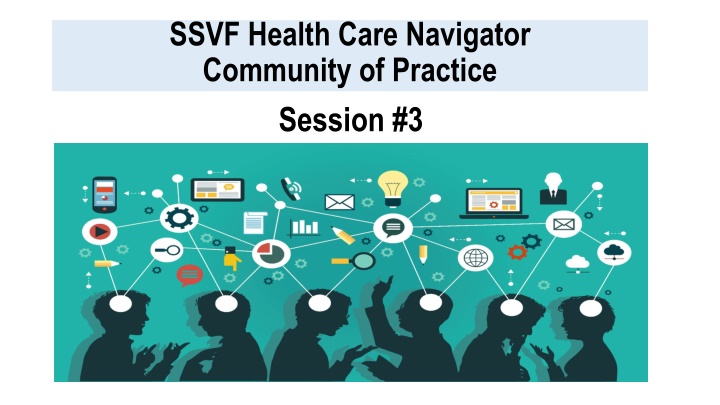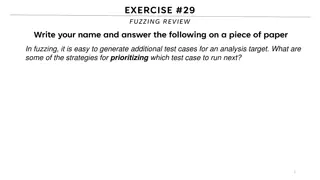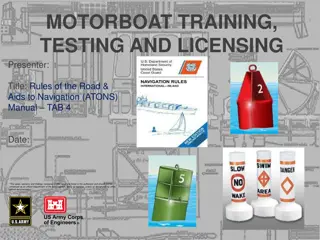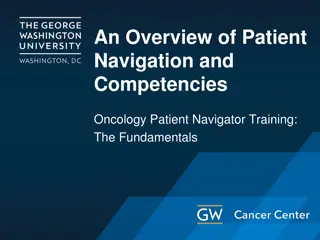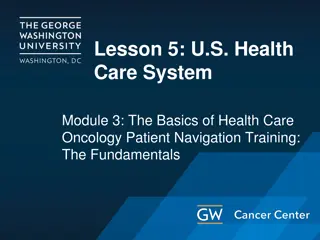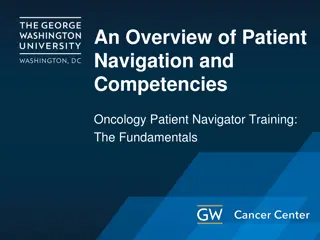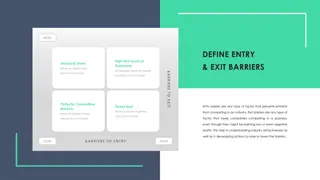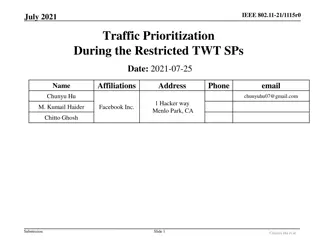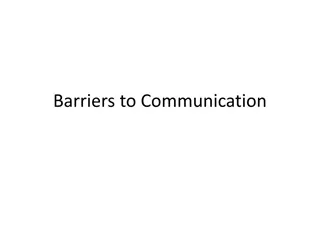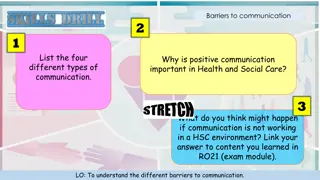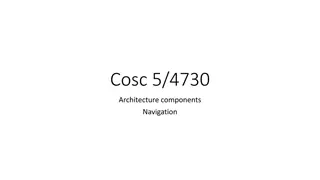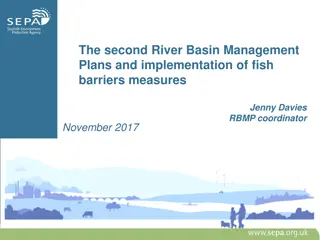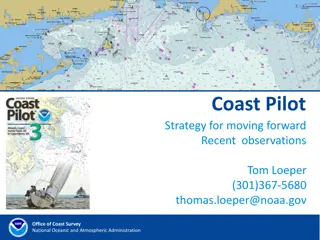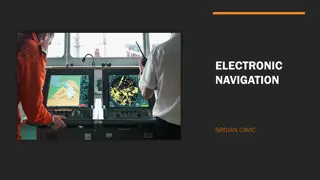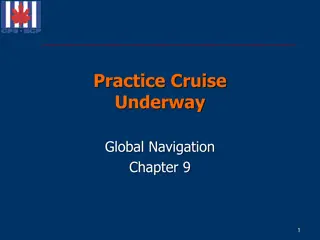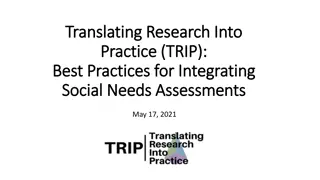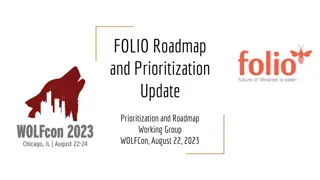Prioritization and Barriers to Care in Health Care Navigation Practice
In this session of the SSVF Health Care Navigator Community of Practice, participants discussed the anticipated caseload size, plan for prioritizing veterans for health care navigation services, messaging strategies, and additional resources for support. Barriers to care such as age, lack of support systems, anxiety, and language barriers were considered. An idea proposed was to follow oncology nurses in determining patient acuity for optimal caseload identification. Anticipated caseload size is personalized based on the complexity of clients' illnesses and life stressors.
Download Presentation

Please find below an Image/Link to download the presentation.
The content on the website is provided AS IS for your information and personal use only. It may not be sold, licensed, or shared on other websites without obtaining consent from the author.If you encounter any issues during the download, it is possible that the publisher has removed the file from their server.
You are allowed to download the files provided on this website for personal or commercial use, subject to the condition that they are used lawfully. All files are the property of their respective owners.
The content on the website is provided AS IS for your information and personal use only. It may not be sold, licensed, or shared on other websites without obtaining consent from the author.
E N D
Presentation Transcript
SSVF Health Care Navigator Community of Practice Session #3
(RE)Introductions Who is here today? Name / Organization / Job State/Catchment area
Sara Urias Sara Urias Health Care Navigators Community of Practice Assignment #2
Prioritization Decisions What is the anticipated caseload size? What is the plan for prioritization of Veterans for Health Care Navigation Services, as needed? Planning should address: Veterans who are not already enrolled in health care Veterans identified as having a complex illness and difficulty accessing care Veterans identified as having mental health or substance use disorders Vulnerable Veterans living in hotels Veteran requesting HCN services who otherwise may not have apparent health care navigation needs How will this prioritization plan be formally messaged to Veterans and partners? What additional resources can be pulled in for supports?
Consider Barriers to Care Age Lack of support systems Anxiety/emotional state Language and communication skills Body mass index Limited Life Skill Physical Mobility Substance abuse Childcare transportation Lack of knowing how the VA health system works Treatment at multiple facilities Health literacy Work/personal conflicts Frailty/ commodities Health literacy Pain
An idea for prioritization? Follow oncology nurses determining patient acuity is the best way to identify optimal patient caseloads for navigators,
Anticipated Caseload Size Will depend on how many problems each client has. For example, I would want to have at max like 25 of clients who have complex illness(es), mental health issues, homelessness, and life stressors (divorce, death, anything life altering).
Additional Supportive Resources National Health Care for the Homeless Council National Groups National Coalition for Homeless Veterans Churches, community centers Churches and community Centers Salvation Army, Catholic Charities
Louverta, Danielle (Catholic Louverta, Danielle (Catholic Community Services Seattle, WA) Community Services Seattle, WA) Health Care Navigators Community of Practice Assignment #2
Prioritization Decisions What is the anticipated caseload size? 25 Louverta and 25 Danielle= 50 How will this prioritization plan be formally messaged to Veterans and partners? Connecting with the case managers, Continuum of Care (CoC) partnership meetings, VA and community partnerships
What is the plan for prioritization of Veterans for Health Care Navigation Services, as needed? Planning should address: how many are in hotels 1. Vulnerable Veterans living in hotels 2. Veterans identified as having a complex illness and difficulty accessing care 3. Veterans identified as having mental health or substance use disorders 4. Veterans who are not already enrolled in health care 5. Veteran requesting HCN services who otherwise may not have apparent health care navigation needs
How will this prioritization plan be formally messaged to Veterans and partners? Connecting with the case managers, Continuum of Care (CoC) partnership meetings, VA and community partnerships What additional resources can be pulled in for supports? H-PACT Team (provider, nurses, social worker) Community resources
Kerri J. Reyes Kerri J. Reyes U.S. Vets Houston U.S. Vets Houston Health Care Navigators Community of Practice Assignment #2
Prioritization Decisions What is the anticipated caseload size? Ideally, a 30-35 veteran caseload seems it would be manageable, based on historical information around SSVF Case Mgmt workload. This will be reevaluated periodically and as needed. The time needed to case manage each veteran s needs, based on their level of need, will be better understood as the role develops.
What is the plan for prioritization of Veterans for What is the plan for prioritization of Veterans for Health Care Navigation Services, as needed? Health Care Navigation Services, as needed? HCN Priority Populations: HCN primary priority populations will include veterans and/or family members who are: Not already enrolled in health care insurance/funding Literally homeless (All RRH cases, living in hotels) Identified as having a complex and/or chronic illness Experiencing difficulty accessing care HCN secondary priority populations will include veterans and/or family members who are: Identified as having mental health AND/OR substance use disorders (Already housed). HCN tertiary priority populations (which will be evaluated on a case by case basis) will include veterans and/or family members whom are: Requesting HCN services who otherwise may not have apparent health care navigation needs. HUDVASH Homeless Prevention Veterans/families (Already enrolled at VHA, current HUDVASH case manager assignment).
How will this prioritization plan be formally How will this prioritization plan be formally messaged to Veterans and partners? messaged to Veterans and partners? Our prioritization plan will be messaged in the following ways: We are drafting a Healthcare Navigation Section to be added into the SSVF Welcome Packet and provided to all new enrollees. This drafted section will include HCN services to be offered and the priority populations/plan detailed in the previous slide. We are also drafting HCN specific informational flyers and pamphlets to be disseminated as needed, which will include prioritization plans.
What additional resources can be pulled in for What additional resources can be pulled in for supports? supports? HUDVASH Case Managers (Local VAMC) Primary SSVF Case Managers (SSVF) Peer Supports / Patient Advocates (Local VAMC) Healthcare for Homeless Programs (Local VAMC) Coordinated Entry Specialist (Local VAMC)
HCN Prioritization Decisions Process Julie Nash, Health Care Navigator
Caseload Size Health Care Navigator anticipate of having a case load of at 25-50 cases.
Prioritizing Cases Prioritize the intensity and urgency of navigation services based on health urgency and complexity. Identifying Veterans and families that are not already enrolled in health care. Identifying Veterans and families having complex illness and difficulty accessing care. Identifying Veterans and families having mental health or substance use disorders. These Veterans and families would be priority over Veterans and families requesting services who may have minor health care needs.
Health Care Navigator Communication Style Health Care Navigator goal is to build trust demonstrating respect and empathy with the Veterans and families. Communicate with SSVF case manager to coordinate services with Veteran. Communicate with VHA or other health settings with the Veterans and, with permission, on behalf of the Veteran. Communicate with the clinical team in order to support the Veteran in understanding the reason and next steps of their care plan. Communicating with Veterans and health care teams about appointments and conduct reminder calls to the Veteran for upcoming health services.
Health Care Navigator Communication Communicating with Veterans and health care teams about appointments and conduct reminder calls to the Veteran for upcoming health services. When possible and with permission, communicate with the family/care givers and provide support to the Veteran and care givers.
Additional Resources to Provide Supports Provide education or create linkages for Veterans and families to learn about wellness related topics. Match health materials and modality to the health literacy level and cultural needs of the Veteran. Educational materials may cover health topics such as smoking cessation, diabetes management, exercise and COVID-19 risk and safety guidelines. Connect the Veteran to support groups or other programs at the VA or in the community to support their health goals.
Round Robin: Assignment #2 Lessons Learned What is the anticipated caseload size? What is the plan for prioritization of Veterans for Health Care Navigation Services, as needed? Planning should address: Veterans who are not already enrolled in health care Veterans identified as having a complex illness and difficulty accessing care Veterans identified as having mental health or substance use disorders Vulnerable Veterans living in hotels Veteran requesting HCN services who otherwise may not have apparent health care navigation needs How will this prioritization plan be formally messaged to Veterans and partners? What additional resources can be pulled in for supports?
HCN Role, Responsibilities, and Boundaries
Reminder: Stay in Your Lane Health Care Navigator Functions Communication Facilitate Access to Care Reduction of Barriers Coordination of Care Patient Education Advocacy
Health Care Navigators help veterans with: Gaining access to health care Supporting health care plans by identifying barriers to care Providing education on wellness related topics
Health Care Navigation Process Diagram Source: Module 1: Role of the Health Care Navigator, Participant Manual - Page 25
Veteran Culture Dominant (Military) All Veterans who successfully complete basic training internalize military culture. Survival depends on standards that reinforce military values over personal beliefs. Military service members walk the same, stand the same, and adopt the same patriotic belief system to become one mind . Sub-Culture (racial, ethnic, religious, class, environmental, etc) Individual cultures & beliefs are buried beneath military standards. The uniform covers everything. But once service members leave the military, Veterans face the same cultural challenges (racism, poverty-related discrimination, etc.) and are no longer protected by military roles that allow them to rise to their potential.
Military Service Core Values: Honor & Integrity In addition, each service has its own specific values that are taught to new recruits from the beginning of their time in service. The Army values are: Loyalty, Duty, Respect, Selfless Service, Honor, Integrity, and Personal Courage Navy and Marine Corps values are: Honor, Courage, and Commitment Air Force values are: Integrity First, Service Before Self, and Excellence in All We Do Coast Guard values are: Honor, Respect, and Devotion to Duty Source: Understanding the Military: The Institution, the Culture, and the People Page 9 (military_white_paper_final)
Military Service Core Values: More than words The values of each of the services are more than a list of terms that young recruits must learn and repeat on command; these values define how each service member lives his or her life, approaches every duty, and succeeds at every mission Source: Understanding the Military: The Institution, the Culture, and the People Page 9 (military_white_paper_final)
Use military values to increase motivation within the engagement process
Military Values: Barrier to care? Active duty service members are often ostracized for complaining about physical or mental health needs. Verbalizing suicidal ideation can result in removal from duty, and loss of military career. Internalized values can remain a barrier to willingness to accept help. It can also be converted to a strength. Although some Veterans reject any association with their military experiences, culture, and values, they remain below the surface. By helping Veterans see their military values as a strength, Veterans can be motivated to seek the care they need without feeling like a failure .
Using Military Values Loyalty - Loyalty to themselves and their families can be a good motivator to enter and make progress in processes. Respect - Many of the symptoms of untreated combat stress and substance use disorders have sometimes led to behavior that the military would judge as disrespectful to the service member or Veteran, the Veteran household, and society as a whole. Working on these conditions and reducing their symptoms can be presented as a way to enhance respect. Selfless service - The symptoms of untreated disorders can sometimes impair people s ability to be of service. Accepting help can be presented as a way to improve service members and Veterans ability to be of service. Honor and integrity - The symptoms of untreated disorders can sometimes influence people to act in ways that the military would judge as dishonorable or dishonest. Making progress in overcoming these disorders can be presented as a way to strengthen one s honor and integrity. Source: Understanding the Military: The Institution, the Culture, and the People Page 31 (military_white_paper_final)
Using Military Values (continued) Excellence and commitment - People with a commitment to excellence can use that commitment to approach the work of stress management, growth, and healing. Personal courage - The process of admitting, confronting, and learning to manage the effects of combat and operational stress requires great personal courage. Any step in this direction is a sign of courage. Devotion to duty - Service members and Veterans function as individuals, family members, community members, and citizens. They have a duty to operate responsively and appropriately. Source: Understanding the Military: The Institution, the Culture, and the People Page 31 (military_white_paper_final)
Did you get it right? How do you know? Ask the Veteran you are serving Conduct surveys with other Veterans Look for other ways to get feedback from Veterans with lived experience to insure continuous improvement
Case Scenarios: Apply process flow, prioritization, and coordination plan to Veteran scenarios
Case Scenarios The following case scenarios are an opportunity to apply your process flow, prioritization and coordination plan based on Veteran responses to the screening questions: Do you have any questions or concerns that you need help in addressing at this time? Do you have health goals for yourself that you need support in addressing?
Case Scenario #1: Mya Mya is a fifty two year old Veteran. She has two children ages sixteen and fifteen years old. After the recent death of her mother, which resulted in the foreclosure of their home, Mya and her kids were staying at a local shelter. While at the shelter, Mya was connected to and enrolled in the SSVF program in April 2020. Due to the COVID 19 pandemic and related concerns about her health as Mya has diabetes and sickle cell anemia, her family was immediately supported in moving into a motel with Emergency Housing Assistance.
Case Scenario #1: Mya (continued) Since her enrollment Mya has repeatedly expressed a desire to find a permanent place to live with her kids. However, her housing case manager, Monica, has scheduled several appointments with Mya to see units and almost all have had to be rescheduled due to her having significantly low blood sugar due to complications with controlling her diabetes. Mya has indicated that she does not have an identified doctor at this time and normally handles concerns with her blood sugar by going directly to the ER or Urgent Care. She realizes that sometimes her health is a barrier to her goal of permanent housing, but she only wants to focus on housing at this time.
Considerations for #1: Mya Prompt 1: How would you address her concerns and broach the subject of using the HCN services through your agency? How would you present this is a service that could be beneficial for her? Prompt 2: Your initial conversation with Mya was successful and she has agreed to meet with you as the HCN while continuing to work with Monica as her housing case manager. How do you describe the differences between your role as HCN and Monica s role as housing case manager?
Additional Considerations for #1: Mya Prompt 3: Your agency is transitioning to having individuals and families who have been enrolled in EHA for over three months engage in cost sharing. Mya has expressed concerns to you as her HCN about how best to budget for her stay at the motel and for housing. Do you support her as her HCN or assist in connecting her with her case manager? Prompt 4: While meeting with Mya you notice that she isn t selecting the best food options. Her hotel room doesn t have a refrigerator or storage so she often purchases fast food which could be impacting her diabetes and ability to budget. Prompt 5: As Health Care Navigation is a time limited intervention, what would you also want to work on with Mya to prepare for when HCN services are no longer available?
Case Scenario #2: Joe Joe is 35 year old Veteran who suffers from PTSD. He has been experiencing homelessness for nearly two years. During that time, he stayed in several encampments by the river, under a bridge, in a patch of woods. At first he stayed with others, but then he decided to camp solo. He is very mistrustful, but after three visits with an SSVF staff who brought him food and a blanket, he was willing to discuss some of his health concerns. He is most concerned about losing most of the feeling in his fingers. He thinks it may be due to the cold. He smokes and drinks quite regularly because it makes him feel less nervous. He saw a VAMC doctor once, but the next time he walked into the clinic, that doctor wasn t there, so Joe left. He hasn t been back since.
Considerations for #2: Joe Prompt 1: What are your first priorities for working with Joe? Prompt 2: The HCN is able to convince Joe to go to the VAMC emergency department and tells him the SSVF Housing Specialist will move him into a motel as soon as the VAMC checks things out. The VAMC ascertains that Joe is not having a stroke and sets up several additional tests over the next two days. Joe says he can t go to the appointments as it s too hard. What might you explore with Joe ?
Additional Considerations for #2: Joe Prompt 3: Imaging suggests the numbness is due to pinched nerves due to arthritis. The doctor prescribes medication and tells him if this gets worse, he may need surgery. The doctor also tells Joe that drinking might be one of the reasons for his numb fingers and that if so, it could get worse if he continues to drink. The Housing Specialist takes Joe to the motel. What assistance would the HCN provide at this point? Prompt 4: As Health Care Navigation is a time limited intervention, what would you also want to work on with Joe to prepare for when HCN services are no longer available?
DISCUSSION 50
